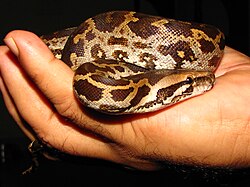Python molurus
Python molurus is a large nonvenomous python species. It is found in many tropic and subtropic areas of South Asia and Southeast Asia.
| Python molurus | |
|---|---|

| |
| Near Nagarhole National Park | |
| Conservation status | |
| Scientific classification | |
| Kingdom: | Animalia |
| Phylum: | Chordata |
| Class: | Reptilia |
| Order: | Squamata |
| Family: | Pythonidae |
| Genus: | Python |
| Species: | P. molurus
|
| Binomial name | |
| Python molurus | |

| |
| Distribution of Indian python | |
| Synonyms | |
| |
It has various common names: Indian python,[2] black-tailed python[3] and Indian rock python. The species is limited to Southern Asia. It is generally lighter colored than the Burmese python. It can grow to 3 metres (9.8 ft).[4]
The color pattern is whitish or yellowish with the blotched patterns varying from shades of tan to dark brown. This varies with the terrain and habitat. Specimens from the hill forests of Western Ghats and Assam are darker.[5] Those from the Deccan Plateau and east coast of India are usually lighter.[5]
The longest scientifically recorded specimen, which came from Pakistan, was 4.6 metres (15 ft) in length and weighed 52 kilograms (115 lb).[6]
Python Molurus Media
Swimming at Keoladeo National Park
Swallowing a chital in Mudumalai National Park
References
- ↑ McDiarmid RW, Campbell JA, Touré T. 1999. Snake Species of the World: A Taxonomic and Geographic Reference, vol. 1. Herpetologists' League. 511 pp. ISBN 1-893777-00-6 (series). ISBN 1-893777-01-4 (volume).
- ↑ Python molurus (TSN {{{ID}}}). Integrated Taxonomic Information System.
- ↑ Ditmars RL. 1933. Reptiles of the World. Revised Edition. The MacMillan Company. 329 pp. 89 plates.
- ↑ Wall F. 1912. A popular treatise on the common Indian snakes – the Indian python. Journal of the Bombay Natural History Society 21: 447–476.
- ↑ 5.0 5.1 Rhomulus Whitaker: „Common Indian Snakes – A Field Guide“; The Macmillan Company of India Limited, 1987; pp. 6-9; SBN 33390-198-3
- ↑ Minton S.A. 1966. A contribution to the herpetology of West Pakistan. Bulletin of the American Museum of Natural History 134 (2): 117–118. [1]
Other websites
| Wikimedia Commons has media related to Lua error in Module:Commons_link at line 62: attempt to index field 'wikibase' (a nil value).. |
- Python molurus at the TIGR Reptile Database. Accessed 13 September 2007.
- Indian Python Archived 2007-06-11 at the Wayback Machine at Ecology Asia. Accessed 13 September 2007.
- Indian python Archived 2012-05-04 at the Wayback Machine at Animal Pictures Archive Archived 2007-07-16 at the Wayback Machine. Accessed 13 September 2007.
- Watch Indian rock python (Python molurus) video clips from the BBC archive on Wildlife Finder Archived 2010-11-06 at the Wayback Machine






